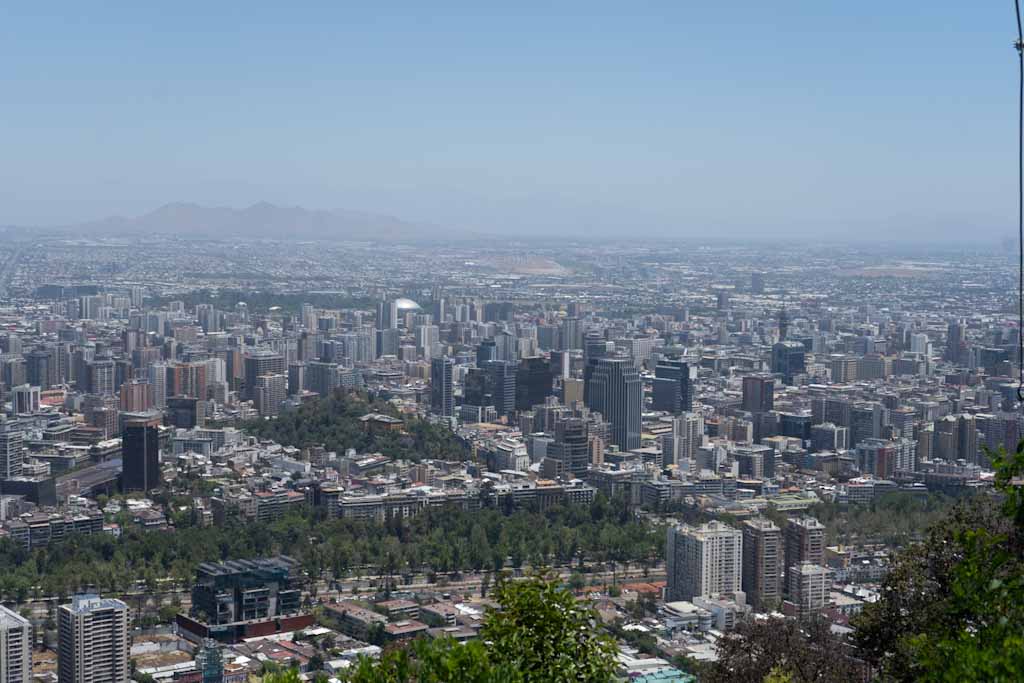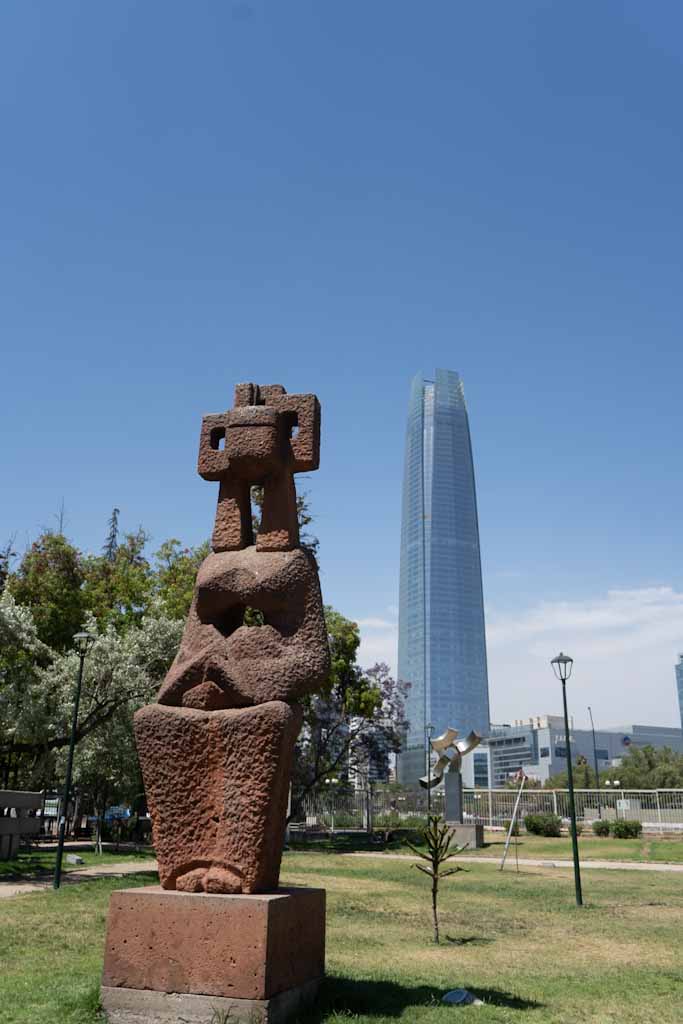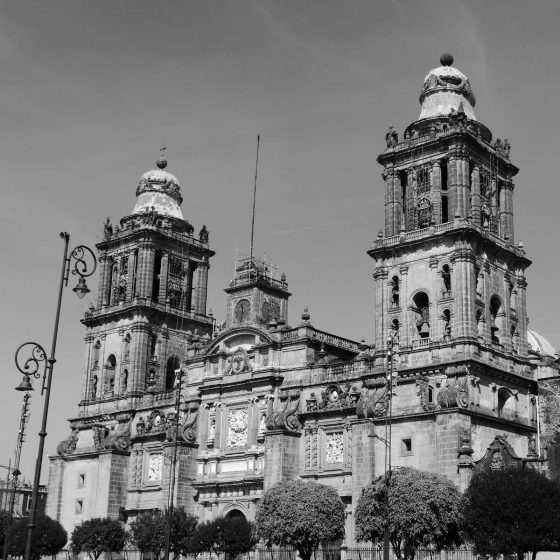The city where you never know whether there are clouds or whether it is fog. With the spectacular background of the Andes mountains, locked into a bowl, Santiago de Chile is a city with many faces.
(more pictures of Santiago de Chile can be found here)
With a population of between 6 and 7 million it is comparable to Bogota, but it is not nearly the urban mess of the Colombian capital. With a well-developed metro system and a relatively high standard of living, this is one of the safest and best Latin American capitals to live in. But it is, of course, still a concrete jungle.
CONTENTS
General introduction
In sharp contrast to my hometown of Berlin, Santiago has many differrent neighborhoods that effortlessly seem to blend into eachother. Centro is strange, with its magnificent Plaza de Armas surrounded by ugly concrete office blocks and the gorgeous La Moneda palace. It tends to become a bit dodgy at night when there are less people around.
On the northern side you will find Recoleta, a vibrant working class district with great food and the general cemetery. On the right side of the center you will find Bellas Artes, with museums and a nightlife district, and Lastarria with its bohemian vibe and funky cafes.
Even further east is Providencia, which blends into Las Condes. It transforms from grubby low-price shops into the Costanera skyscraper with huge shopping mall into Las Condes with the swanky Parque Arauqo shopping mall and luxury living.
South of the center is the hipster up-and-coming Barrio Italia and the small Barrio Paris y Londres close to La Moneda. And west of the center is the Barrio Brasil with street art, good food and bars, the Barrio Yungay with museums and a theater, and south of it working class Barrio Republica. The central station and most of the bus terminals form the western end of the city center.
If you venture beyond, there is not that much to see. But with a few exceptions (see Miscellaneous below) you will also be safe within this huge space of Santiago. A good point of reference is always the Avenida Libertador Bernardo O’Higgins, better known by locals as the Alameda, which runs from east to west right through the heart of the city.

Food and drinks
Being a capital, you can obviously find any kitchen yo are looking for. This is of course ALSO highly determined by where we stayed. The first visit was in Barrio Republica, where there are many nice bars and restaurants around the park at Grajales. On the other side of Avenida O’Higgins you dive straight into Barrio Brasil, with the Avenida Brasil as its main gastronomy focal point. The Avenida Ricardo Cumming also has plenty of choice though.
During the second visit we stayed in the Barrio Paris y Londres. That is a vibrant area, but when you go to the other side of O’Higgins you are in Lastarria (lovely cosy Latin feel east of Cerro Santa Lucia) and Bellas Artes with plenty of options. Bistro De la Barra and and Emporio La Rosa are excellent for lunch and coffee.
The further east you go, the posher it gets. That goes for Providencia, which still has plenty of cheap options. Beyond the Costanera tower everything is plain expensive.
Activities / things to do
- Barrio Brasil & Yungay:
- there is the nice Centro Cultural Matucana 100, a theatre built out of wood on the ruins of a former building. It also has a nice coffee garden
- it is located on the edge of a park. Nearby is the Espacio Quinto Normal, which is an annex of the Museo de Arte Contemporaneo in the center
- in the same area is the Museo de la Memoria y los Derechos Humanos. The building is as impressive as its exhibition, about the atrocities committed during the military dictatorship of Gustavo Pinochet in Chile in the 70s and 80s. Take several hours to soak up all the information and testimonials
- only three blocks away there is the NAVE, a cultural center which often has performances at night. There is a great coffee shop / old library fifty metres away
- these entire barrios are full of street art if you wander around, but are also nice old-fashioned in sharp contrast to the many concrete residential towers elsewhere in Santiago
- Barrio Bellavista & Centro:
- slightly north of the city center, the focal point here is Cerro San Cristobal. You can go up by a funicular (steep train) or by cable car (from the other side of the mountain) or by foot. Once at the lookout, there are great views all over the city. At the top of the funicular is also Terrazza Bellavista for snacks. If you continue walking around the mountain you will discover two public swimming pools and a (rather disappointing) botanical gardeń
- Cerro Santa Lucia is much smaller, but also easier to ascend by foot and also provides beautiful views of Santiago
- Mercado Central: we had mixed feelings about these nice old market halls. Part of it is a fresh fish market. But the other part is a huge food court with apparently excellent fish food, unfortunately being praised by screaming owners trying to lure tourists in. And if I am allergic to one thing, it is… exactly
- south of the center is the small barrio Paris y Londres, draped around two cobblestoned streets (Paris and Londres). In one of the streets is a museum about the former interview prison of the dictatorship that was there, which has very limited opening hours
- Barrios Lastarria & Bellas Artes
- the Museo Nacional de Bellas Artes is in a beautiful classicist building. The collection though was disappointing, the temporary exhibitions cool but small
- same goes for the Museo de Arte Contemporaneo, which has its own entrance but is back-to-back with the Bellas Artes. Both are usually free to visit
- Centro Gabriela Mistral is a massive arts and cultural center housed under an equally massive rusty steel roof. It is actually a collection of buildings and squares united by that roof. You find theatres, galleries, a library and much more here
- Providencia:
- the most visible part is of course the Sky Costanera, the highest building of Chile (300 metres) with a lookout platform which charges a hefty entrance fee. It is in the heart of Providencia, with a huge shopping mall around it, and plenty of streets with more expensive bars and restaurants
- Parque de los Esculturas: slightly north of it along the water is this nice sculpture park, a great example of urban redevelopment. In recent years a walking boulevard has been constructed along the two canals here, which are quite nice despite the massive traffic surrounding it
- various:
- Cementerio General, the general cemetery a decent walk north of the center of Santiago. This city of tombs is massive and has several imposing buildings (what the hell is that Italian pavillion doing there?)
- Parque por la Paz memorial park: far in the east of the city, in a place called Villa Grimaldi, is this park with recollections of the victims of the dictatorship
- Park O’Higgins: the green lung of the city is not nearly as big as the one in Mexico City for example, but still nice and much-needed. On the northern end it also has a theme park (Fantasilandia) wioth rides, and the Movistar arena for huge indoor concerts
- Museo Ralli: in the northeast more or less in Las Condes is this small modern art museum
Getting to Santiago and getting around
- the international airport is a bit west of the city. There are two bus companies transporting passengers to the city center (Los Heroes stop is the end of the line), or you take the first stop and jump on the central L1 subway line
- by bus: the biggest bus terminals (Alameda) are also very close to the central train station (Estacion Central). Not all long-distance buses stop here though, Turbus has a separate terminal one block further as well
- by train: Estacion Central. There are a couple of trains leaving and arriving here, one of them to Talca and beyond to Chillan
- getting around: the city is massive. You can do the city center by foot, but the safe and fast and cheap subway is a very good alternative. It is accompanied by the minibus system. You need a BIP card for payments
Miscellaneous
- Weather: hot and dry in summer, with temperatures hovering around thirty degrees for several months. Then it becomes rainy and significantly colder for around four months in winter, with snow in the surrounding mountains
- Safety: is an issue in some crowded places full of street vendors when they empty in the evening. Around central station and basically everywhere in the center you have to be cautious. All other areas should be fine, Las Condes is totally safe
- Vinyl stores: for hardcore music lovers, there are two or three blocks in Providencia with 5-10 record stores. Google for Nextime (avenida Providencia 2216) and in the area you will also find Sonar, Vinilos por Mayor, Funtracks and more





